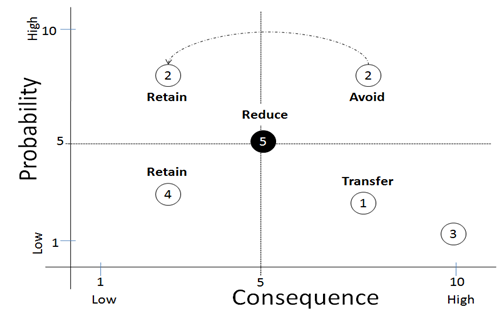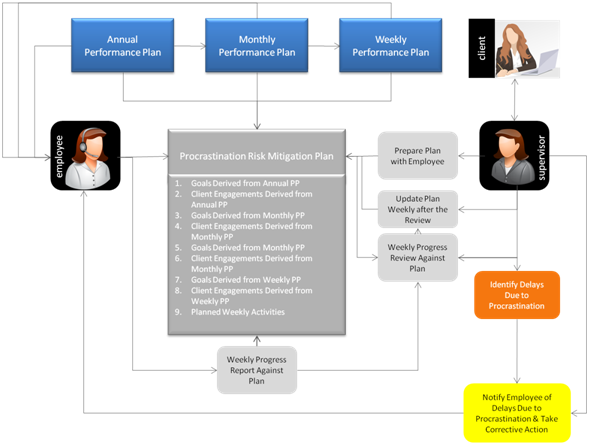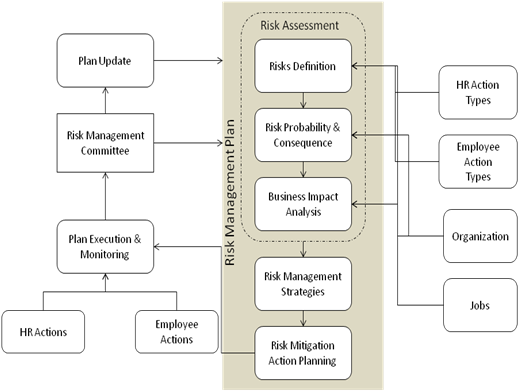Overview
Research has shown that employees’ procrastination cost companies billions of dollars per year. Further, research has shown that on average, employees waste 1.5 hour per day procrastinating. So, let’s assume that your company has 100 employees, and each employee is wasting 1.5 hour per day (7.5 hours per week per employee), that is a total of 750 hours (7.5 x 100) of lost time per week. Assume that the average pay rate per employee is $18.00 per hour, so the company is incurring a loss of $13,500 per week, which translates to an annual loss of approximately $702,000. This loss addresses the loss resulting from lost time, where employee delays doing his/her work by doing something that is irrelevant to his/her work and to the company business such as checking his personal emails, facebook, twitter, chatting with friends, etc. The impact on the business in term of loss of sales opportunities, loss of clients due to poor support and timely response, not meeting projects’ planned deadlines, etc, is much larger, and as a matter of fact it can ruin the company. Procrastination crosses all position levels in the company, from the line staff (low level position), to the mid level management, such as sales management, all the way to the top of the pyramid. Procrastination comes in three flavors, (1) Priority dilution, employees spend most of their time on work that is not high priority and delay most of the important work which have great impact on the performance of the company, (2) Creative Avoidance, in this case the employee likes to stay in his/her comfort zone, and do just enough to finish the day, and (3) Decision Dodging, this is when the employee, and specifically a manager delays making decisions on critical issues that can impact the operation and the performance of the organization. All in all, procrastination greatly impacts the operational and financial performance of the organization, and if left unresolved, it will greatly contribute to the failure of the company/organization from achieving its strategic, financial, and operational goals. Management must address procrastination as a major risk to the organization/company that needs to be identified and mitigated, and not left dangling; otherwise it can mushroom and ruin the company/organization. In the rest of this blog, I shall describe how HRMS can be used as a solution to identify and mitigate procrastination within your Company/Organization,
Mitigating Procrastination using Risk Management
Given the great negative impact of Procrastination on the Organization/Company Financial and Operational Performance, we strongly recommend that employee procrastination be treated as a major risk to the organization. In this context, this risk needs to be identified, assessed, and mitigated using a Risk Mitigation Plan. If the company has already a Risk Mitigation Plan (RMP) in place, then the Procrastination should by one of the high risks defined in the plan and how to mitigate such a risk should be defined in the plan as well. In fact, you do not have to go through the Risk Assessment process when dealing with Procrastination as a risk, it is given (due to the large pool of research about the impact of Employee Procrastination), just include it in your Risk Assessment Matrix with the Employee as a source of risk, and give it the highest probability of occurrence and a the highest impact on the organization company in term of financial losses and decrease in operational performance. Even, if you do not have Risk Management Process and plan in place. Just create one Risk Management process, called Procrastination Risk Management and build Risk Mitigation Plan for this single risk. And the source of the risk will be all employees including those holding line staff positions and management positions. So Procrastination will be one Risk as shown in the following sample of Risk Definition Chart, and include Procrastination under Employee Actions Risk Assessment dimension:
- HR Actions Risk Assessment
- Recruitment
- Hiring
- Transfer
- Promotion
- Termination
- Compensations
- Remuneration
- Demotion
- HR Activities Risk Assessment
- Performance Management
- Training and Learning
- Succession Planning
- Career Planning
- On-boarding
- Off-boarding
- Probation Planning
- Employee Actions Risk Assessment
- Procrastination
- Bad Behavior
- Abuse
- Lack of Performance
- Absenteeism
- Resignation
- On-the-Job Injury
- Bad Customer Relation
- Job Risk Assessment
- Importance of the Job to the Organization
- Impact if the Job not filled or filled with the wrong candidate
Risk Management Strategies and Planning
A Risk Management Plan (RMP) consists of the following components:
- Risk Assessment
- Risk Management Strategies
- Risk Mitigation Action Plan
Now that you already know the high impact of the employees’ procrastination on the organization performance, you do not need to go through the Risk Assessment and Risk Management Strategies Analysis, meaning Avoid/Eliminate, Retain, Reduce/Modify, or Transfer. The only sound strategy to mitigate procrastination is Avoid/Eliminate as shown in figure-1, or at least the Reduce Strategy. The reason that we have selected the Avoid or Reduce Strategy is that both, the probability of the risk occurring is high (close to 10), and the consequence, the impact on the organization is high (close to 10).
Figure 1: The Risk Management Strategy Matrix
With a risk avoidance strategy, the business takes action to avoid the risk, in this case Employee Procrastination. Typically, this means the business chooses to implement set of policies, procedure, controls and processes, reviews, and tools as actions to eliminate or drastically reduce Employee Procrastination as a Risk. Such processes and tools include:
- Employee Performance Management Plans and Reviews
- Project Management Plans and Reviews
- Customer/Client Surveys and Feedback
- Daily/Weekly Employee Quick Performance Review and Feedback
- Employee Management by Goals and Objectives with specific Target Dates
- Daily/Weekly Employee Progress Reporting against Plans
The above processes and tools are used as part of the selected risk mitigation strategy. And the activities to be used in preparing the Risk Mitigation Plan are derived.
Risk Mitigation Plan
When the organization decides which risk management strategies will be the most effective and affordable for the organization, in this case Avoid/Reduce, the risk mitigation plan will then be prepared. The Risk Mitigation Plan consists of all activities to be conducted to identify the events that can lead to the occurrence of the risk (Employee Procrastination), and the Actions to be taken to avoid the Risk from occurring. As shown in figure-1, Activities that are included in the Procrastination Risk Mitigation Plan are derived from:
- Employee Annual Performance Plan
- Employee Monthly Performance Plan
- Employee Planned Weekly Activities
- Client Engagement Plan
- Sales Targets Plan
- Production Targets Plan
- Projects’ Implementation Plans
- Client Satisfaction Surveys
- Employee Weekly Progress Report
Activities in the Mitigation Plan include a set of review tasks, to review the goals and activities that the employee supposed to achieve/complete during the week against the planned completion dates. And actions to be taken if these goals and tasks are not completed on time as well as the resources responsible for the review and actions. The mitigation plan needs to be reviewed with the employee and his supervisors and managers.
Figure 2: Procrastination Risk Mitigation Plan Model
Plan Execution
Execution of the plan consists of conducting the mitigation activities defined in the plan and taking the mitigation actions if events are occurring that may lead to the occurrence of the procrastination risk. Such events include identifying delays and the cause of the delays and meeting with the employee to identify the causes of delays to ascertain that the delays are not due to the employee procrastination. The plan need to be reviews and updated weekly and shared with employee and his/her supervisor and manager, so the employee is aware of the risk and the actions that need to be implemented to avoid the risk.
Interact HRMS Risk Management
Interact HRMS provides a comprehensive Risk Management (iRisk) solution combined with Performance Management, and Project Management which will enable any organization to implement an effective Risk Management solution to solve the problem of Employee Procrastination and other risk associated problems. The basis of the Risk Management Planning framework are Risk Assessment, Business Impact Analysis, Management Strategies, Risk Mitigation Planning, Action Plan Execution & Monitoring, and Acton Plan Update as shown in the Risk Management Planning Framework, Figure-3.
Figure-3: Risk Management Plan Framework
Conclusion
As you are reading this blog, and if you do not have the right processes and tools in place to mitigate employee procrastination, your organization/company is losing thousands of dollars every week due to employee procrastination and highly likely losing sales opportunities, client satisfaction is degrading, and your organization is not meeting its performance goals. Interact HRMS with it seamlessly integrated Risk Management, Performance Management, Client Management, and Project Management applications/solutions can provide you with the right approach, technology, and solution to implement and deploy the right and effective solution to eliminate or drastically reduce the Employee Procrastination Problem, leading to drastic cost savings and financial and operational performance improvements.




